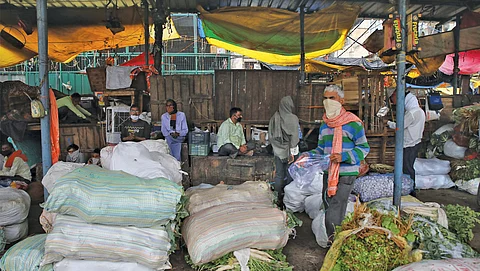

India’s draft National Policy Framework on Agricultural Marketing has reignited concerns among farmer groups, who view it as a renewed push towards the privatisation of wholesale markets—the critical first point of sale for their produce. These markets are not just trading hubs; they determine the demand and prices of all crops and, ultimately, the livelihoods of farmers. For Samyukt Kisan Morcha, an umbrella organisation of 32 farmer unions that led the nationwide year-long protests in 2020-21 against the now-repealed farm laws, the draft policy feels eerily familiar. In a press release, the group called it a “backdoor resurrection” of the very laws that sparked the protests because it will “hand over control” of agriculture and the supply chain “to a few corporates.”
The draft policy was released on November 25, 2024, with a short window of just 14 days for comments. It says that India has 7,057 Agricultural Produce Marketing Committee (APMC) markets, or mandis, regulated under APMC laws enacted in 27 states and three Union Territories. Alongside these, there are 125 private wholesale markets and around 500 unregulated wholesale markets, mostly in states without APMC laws such as Bihar and Kerala. The country also has grameen haats and other small markets that are either under APMC, or run by private players and local bodies.
Although 15 states have permitted private wholesale markets, they currently operate in just five states with limited success. Yet, the draft policy proposes expanding them nationwide. It recommends setting up “one private market in every revenue division of the state” initially, with the goal of scaling up to “at least one in each district.” It also pushes states to adopt a public-private partnership (PPP) model for improving the “infrastructure and facilities” at the APMC markets. “When you are opening up the agricultural market to private wholesale players, why do you also want APMCs under a public-private model? This would mean handing over the day-to-day operations of mandis to private entities,” says Sukhpal Singh, professor and former chairperson of the Centre for Management in Agriculture, Indian Institute of Management, Ahmedabad. Further, private players have been allowed in marketing of horticultural produce in 21 states. “Still, farmers continue to receive poor returns on perishables. These are high-value crops and leaving them to market forces will not serve farmers’ interests,” says Singh. The draft policy is pushing for greater private involvement, but does not provide for a robust grievance redressal mechanism for farmers selling in private markets, a demand farmers have been making since 2020-21.
“While there is a grudging admission in the draft policy that agricultural marketing is a state subject, the Union government could not resist the temptation to intervene,” says R Ramakumar, professor, School of Development Studies, Tata Institute of Social Sciences, Mumbai. It proposes an empowered agricultural marketing reform committee, chaired by the Union agriculture minister, akin to the GST (goods and services tax) Council. The draft further proposes capping market fees collected by APMCs and state agriculture market boards at 1 per cent for perishables and 2 per cent for non-perishables—down from the current 3 per cent for each. The Punjab government has opposed this move, arguing that the revenue is used to establish rural road networks and improve mandi infrastructure.
The draft policy acknowledges gaps in India’s agricultural marketing infrastructure, noting 7,057 regulated wholesale markets —1,144 of them non-functional—are inadequate. It highlights that cold storage facilities exist in less than one-tenth of the markets, grading facilities in less than one-third and electronic weigh-bridges in only a handful. But beyond pushing privatisation, it fails to provide a robust plan to address the issues.
“The policy framework seems to be an under-delivery. The vision is for 10 years, but the interventions it suggests are needed today. Even 10 years ago, the same issues existed,” says Shweta Saini, chief economic officer of policy and research organisation Arcus Policy Research.
The document outlines 12 action areas for states, including private wholesale markets, deregulation of perishables, e-trading platforms and rationalisation of market fees. However, many of these measures are already in place. For instance, 25 states have already notified the rationalisation of market fees, 15 states allow private markets and 12 states have e-trading platforms. “The same old points have been repackaged now,” says Ramakumar.
A critical omission in the draft is that it fails to incorporate livestock marketing, which constitutes a significant portion of a farmer’s income. “For a farmer, livestock is an integral part of their income. However, livestock mandis remain an orphaned child in policymaking,” says Saini.
This was first published in the 16-28 February, 2025 print edition of Down To Earth